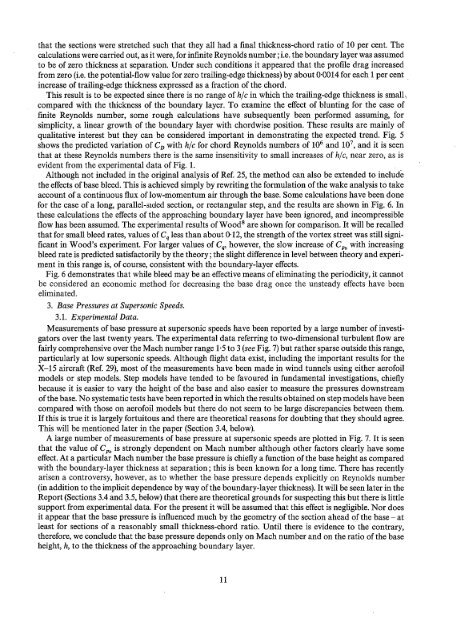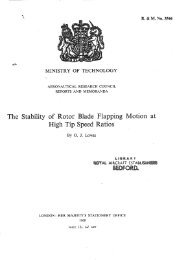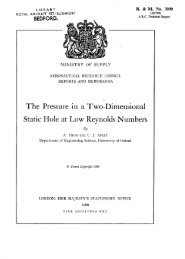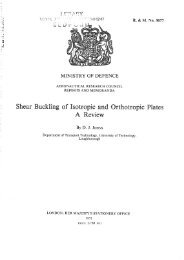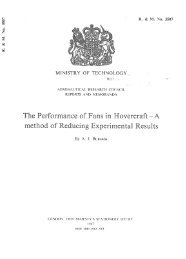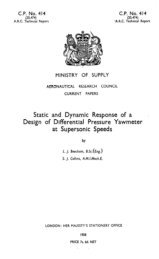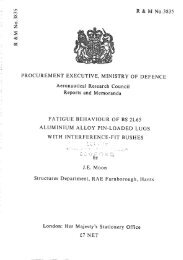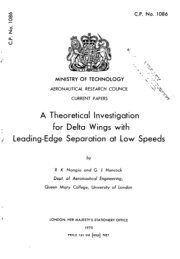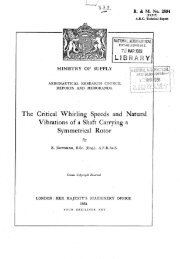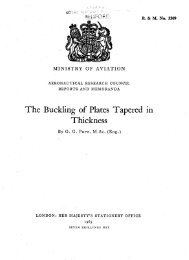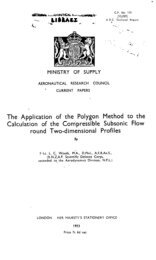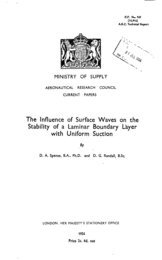A Discussion of Two-Dimensional Turbulent Base Flows - aerade
A Discussion of Two-Dimensional Turbulent Base Flows - aerade
A Discussion of Two-Dimensional Turbulent Base Flows - aerade
You also want an ePaper? Increase the reach of your titles
YUMPU automatically turns print PDFs into web optimized ePapers that Google loves.
that the sections were stretched such that they all had a final thickness-chord ratio <strong>of</strong> 10 per cent. The<br />
calculations were carried out, as it were, for infinite Reynolds number; i.e. the boundary layer was assumed<br />
to be <strong>of</strong> zero thickness at separation. Under such conditions it appeared that the pr<strong>of</strong>ile drag increased<br />
from zero (i.e. the potential-flow value for zero trailing-edge thickness) by about 0.0014 for each 1 per cent<br />
increase <strong>of</strong> trailing-edge thickness expressed as a fraction <strong>of</strong> the chord.<br />
This result is to be expected since there is no range <strong>of</strong> h/c in which the trailing-edge thickness is small~<br />
compared with the thickness <strong>of</strong> the boundary layer. To examine the effect <strong>of</strong> blunting for the case <strong>of</strong><br />
finite Reynolds number, some rough calculations have subsequently been performed assuming, for<br />
simplicity, a linear growth <strong>of</strong> the boundary layer with chordwise position. These results are mainly <strong>of</strong><br />
qualitative interest but they can be considered important in demonstrating the expected trend. Fig. 5<br />
shows the predicted variation <strong>of</strong> C9 with h/c for chord Reynolds numbers <strong>of</strong> 106 and 107, and it is seen<br />
that at these Reynolds numbers there is the same insensitivity to small increases <strong>of</strong> h/c, near zero, as is<br />
evident from the experimental data <strong>of</strong> Fig. 1.<br />
Although not included in the original analysis <strong>of</strong> Ref. 25, the method can also be extended to include<br />
the effects <strong>of</strong> base bleed. This is achieved simply by rewriting the formulation <strong>of</strong> the wake analysis to take<br />
account <strong>of</strong> a continuous flux <strong>of</strong> low-momentum air through the base. Some calculations have been done<br />
for the case <strong>of</strong> a long, parallel-sided section, or rectangular step, and the results are shown in Fig. 6. In<br />
these calculations the effects <strong>of</strong> the approaching boundary layer have been ignored, and incompressible<br />
flow has been assumed. The experimental results <strong>of</strong> Wood s are shown for comparison. It will be recalled<br />
that for small bleed rates, values <strong>of</strong> Cq less than about 0"12, the strength <strong>of</strong> the vortex street was still signi-<br />
ficant in Wood's experiment. For larger values <strong>of</strong> Cq, however, the slow increase <strong>of</strong> Cpb with increasing<br />
bleed rate is predicted satisfactorily by the theory; the slight difference in level between theory and experi-<br />
ment in this range is, <strong>of</strong> course, consistent with the boundary-layer effects.<br />
Fig. 6 demonstrates that while bleed may be an effective means <strong>of</strong> eliminating the periodicity, it cannot<br />
be considered an economic method for decreasing the base drag once the unsteady effects have been<br />
eliminated.<br />
3. <strong>Base</strong> Pressures at Supersonic Speeds.<br />
3.1. Experimental Data.<br />
Measurements <strong>of</strong> base pressure at supersonic speeds have been reported by a large number <strong>of</strong> investi-<br />
gators over the last twenty years. The experimental data referring to two-dimensional turbulent flow are<br />
fairly comprehensive over the Mach number range 1.5 to 3 (see Fig. 7) but rather sparse outside this range,<br />
particularly at low supersonic speeds. Although flight data exist, including the important results for the<br />
X-15 aircraft (Ref. 29), most <strong>of</strong> the measurements have been made in wind tunnels using either aer<strong>of</strong>oil<br />
models or step models. Step models have tended to be favoured in fundamental investigations, chiefly<br />
because it is easier to vary the height <strong>of</strong> the base and also easier to measure the pressures downstream<br />
<strong>of</strong> the base. No systematic tests have been reported in which the results obtained on step models have been<br />
compared with those on aer<strong>of</strong>oil models but there do not seem to be large discrepancies between them.<br />
If this is true it is largely fortuitous and there are theoretical reasons for doubting that they should agree.<br />
This will be mentioned later in the paper (Section 3.4, below).<br />
A large number <strong>of</strong> measurements <strong>of</strong> base pressure at supersonic speeds are plotted in Fig. 7. It is seen<br />
that the value <strong>of</strong> Cpb is strongly dependent on Mach number although other factors clearly have some<br />
effect. At a particular Mach number the base pressure is chiefly a function <strong>of</strong> the base height as compared<br />
with the boundary-layer thickness at separation ; this is been known for a long time. There has recently<br />
arisen a controversy, however, as to whether the base pressure depends explicitly on Reynolds number<br />
(in addition to the implicit dependence by way <strong>of</strong> the boundary-layer thickness). It will be seen later in the<br />
Report (Sections 3.4 and 3.5, below) that there are theoretical grounds for suspecting this but there is little<br />
support from experimental data. For the present it will be assumed that this effect is negligible. Nor does<br />
it appear that the base pressure is influenced much by the geometry <strong>of</strong> the section ahead <strong>of</strong> the base - at<br />
least for sections <strong>of</strong> a reasonably small thickness-chord ratio. Until there is evidence to the contrary,<br />
therefore, we conclude that the base pressure depends only on Mach number and on the ratio <strong>of</strong> the base<br />
height, h, to the thickness <strong>of</strong> the approaching boundary layer.<br />
11


